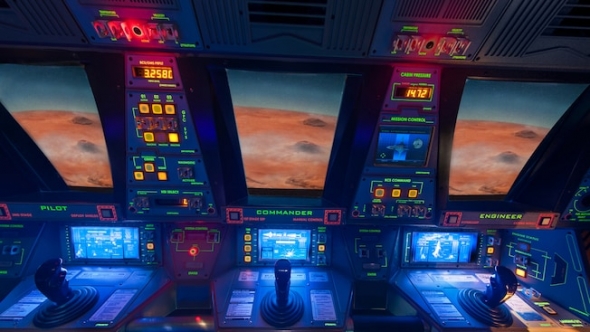Luigi’s Flying Tires
I almost hate listing Luigi’s Flying Tires. Imagineers had their hearts in the right place when they built this attraction. Alas, history has a tendency to repeat itself.
During the early 1960s, Imagineers constructed a revolutionary ride system for an attraction called Flying Saucers. The concept is akin to air hockey in that guests would “float” in the air thanks pressured system beneath each ride cart. There was just one little problem. The individual carts were a one size fits all solution to a kind of ride that required nuance. Some riders were too small to move their carts while the *ahem* girth of others slowed down the potential motion of the Flying Saucers. In addition, the attraction had terrible throughput and frequent malfunctions. After a few years, Disney mothballed the concept.
Fast forward to the advent of Cars Land at Disney California Adventure. Since Luigi’s Tires is a crucial and fun element of the Cars movie franchise, Disney wanted a ride based on that premise. After some research, they determined that the Flying Saucers premise was viable using modern technology. They…were wrong.
Even before Luigi’s Flying Tires opened, park officials knew it was a bust. They tried tinkering with it some, but their biggest change, a multi-person ride cart, didn’t solve the underlying issues with pressurized air distribution. The “flying tires” were slow to the point of immobile. Disney tried to jazz up the proceedings by adding beach balls, part of the blue sky phase for Flying Saucers way back when. All that did was get them sued by people struck by beach balls. Seriously.
Less than three years after its arrival, Luigi’s Flying Tires closed, giving it a certain sort of symmetry with Flying Saucers. Maybe Disney will break out the concept again in the 2060s.
Mission: Space
Image: DisneyThis ride is the most chronicled struggle Disney has faced during the 2000s, at least among rides still in operation. From early on, Imagineers intended to simulate space travel with their daring new attraction. To accomplish their dream, they’d need to construct a multi-arm centrifuge. This device would spin the ride carts at certain angles to create the illusions of thrust, g-force, and weightlessness.
While Imagineers understandably had concerns about causing motion sickness, they employed subtle tricks to lessen the ideas of it transpiring. For example, the airflow in each ride cart is intended to relax the body and thereby steady the nerves. Unfortunately, something that sounds good in theory can fail completely in execution. That’s precisely what happened with Mission: Space.
During the early days of the attraction’s opening, park officials quickly realized that the g-force simulations were too stressful for many guests. The modest steps that Imagineers had taken to lessen the possibility of motion sickness were woefully inadequate. Many guests who rode Mission: Space regretted, well, everything and exited the ride feeling sick and rather angry. Some became physically ill and…the story gets much sadder from there in a couple of instances.
Mission: Space failed so completely during its first iteration that Disney had to add a second option. They removed the centrifuge’s high-gravity elements, creating a gentler ride experience. A few years later, Disney differentiated the two rides beyond “centrifuge and no-centrifuge” options. The more violent iteration of the ride still travels to Mars while the calmer one orbits the Earth. These changes work much better, but Mission: Space will always be known as the ill-fated Disney attraction that tragically includes a body count.


Add new comment